Euro size beds are becoming increasingly popular. This is due to the increasing demand for fitted sheets that can be made by hand. Factory products do not always fit the size of mattresses for euro beds, so it is useful to know how to make them yourself.
How to sew a fitted sheet
Those who are making a pattern for sewing a sheet on their own may encounter difficulties. For example, the width of the fabric does not always correspond to the required width of the future sheet. The fabric is added to the width of the mattress (approximately 60 cm), it goes to the hem on both sides.
Another problem is repeating the round edges of the mattress. Without sewing experience, there is a risk of shifting the edges of the sheet, which will make the sheet lie unevenly and stick out at the edges.
Before constructing the pattern, carefully check the consumables and calculate the parameters of the mattress. In some cases, small paper patterns are prepared before sewing to ensure that the fabric will lie evenly on all edges.
Construction of the pattern
Making a fitted sheet with your own hands requires precise calculation of consumables.
The modern standard width of fabric is about 220 cm. This amount of fabric is enough to make any sheet, except for a fitted sheet. In order for this fabric to be enough to make a sheet, you need to add the size of one of the sides.
To calculate the required amount of material, take measurements of the mattress:
- Length, height, + 15 cm (hem). A standard Euro mattress is 2 m long and about 20 cm high. With these parameters, 2 m 70 cm of fabric is required.
- Width, height, + 15 cm (for hemming). A standard Euro mattress takes up 1 m 80 cm, which means 2 m 50 cm of fabric is required for sewing.
From the calculation data it is clear that a regular piece of fabric is not enough to make a fitted sheet, so it is necessary to increase one side on the blank. It is not recommended to buy fabric with large fragments of the pattern, preference is given to small ornaments or geographic patterns.
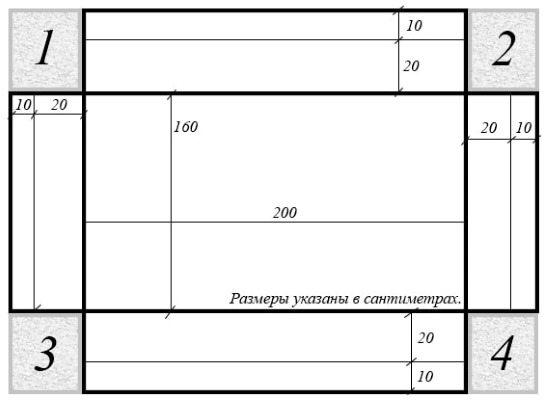
The pattern is enlarged at the top so that the seam is at the headboard for aesthetic reasons: the seam is not visible under the pillows. About 30 cm are added to the selected side to increase the length. In total, the fabric consumption is 3 m by 2.5 m.
Hemming
Many people prefer fitted sheets made by hand because they do not bunch up, unlike regular sheets. The disadvantage of this type of sheet is its high cost due to the increased consumption of fabric. Many people note that sewing a fitted sheet is more difficult than a regular one. But a pre-planned cutting process simplifies the task.
The fabric itself serves as a pattern. The marking is done with a simple pencil, since the back of the materials for sewing bed linen is lighter than the front side. When the marking is finished, cuts are made with scissors, taking into account the allowance for the connecting seam.
The required hem width, the type of elastic band, and the place where the seams will be joined are thought out in advance. The deeper the elastic band goes under the mattress, the tighter and smoother the sheet will lie. But this increases the consumption of fabric and elastic band, the total cost of the sheet, and the cut becomes more complicated.
Therefore, it is recommended that beginning seamstresses make their first sheet with a small fold (no more than 7 cm), while inserting the elastic only into the corners. If calculated correctly, this type of sheet will also lie flat on the surface.
When the calculations are finalized and verified, they are transferred to the fabric and they begin trimming the excess fabric from the corners along the bottom. The upper part is not trimmed, since in this place a section of fabric is built up from corner to corner.
A fitted sheet made by yourself implies cutting taking into account the seam allowance and hemming. This process includes many little things, so it cannot be described in one instruction. Any instruction is further modified taking into account the parameters of the mattress, the material for sewing, etc.
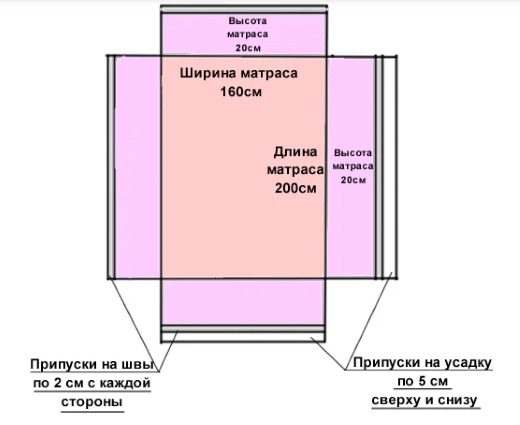
A sheet that is not designed for the rounded edges of a mattress will bunch up. To avoid this effect, copy the rounded edge of the mattress onto the pattern using paper. Before cutting out the corner of the fabric, take into account the seam allowance and lining.
To make sure that the measurements are correct, the pattern is folded in half and the diagonals of the mattress and fabric are compared. All parameters may be distorted when transferred to the fabric. The diagonal on the fabric is made slightly longer than on the pattern. This is done based on the shrinkage of the material.
Inserting elastic and finishing the hem
To sew the pattern pieces together, use strong threads (not thick ones). The main criterion for selection is that the thread does not break later from moisture and does not form holes in the places where the needle punctures. To prevent the needle from damaging the fabric during sewing, a not too frequent step is chosen, usually a medium step is enough.

The seams of the pattern are connected using a linen stitch. This seam securely holds the pattern pieces together, but sticks out at the corners. It is also processed with an overlock (not a zigzag), then for reliability, a connecting stitch is used next to it.
Before you start processing the edge of the hem, calculate the required amount of elastic. The amount of material depends on its quality: weak elastic is used in a circle hem, since after washing it will weaken more. In another case, use a zigzag stitch with a special foot. To prevent the elastic from weakening, it is sewn on with a wide step.
Wide elastic is used along the edges. This material saves fabric, since it does not require extra material for hemming. After frequent washings, the wide elastic does not weaken and the product remains in its original form longer.
Fitted Sheet with Drawstring
When sewing a sheet with an elastic band in a drawstring, the calculation of material consumption remains the same as described above. When choosing fabrics, pay attention to their quality, since the material may shrink during subsequent washing.


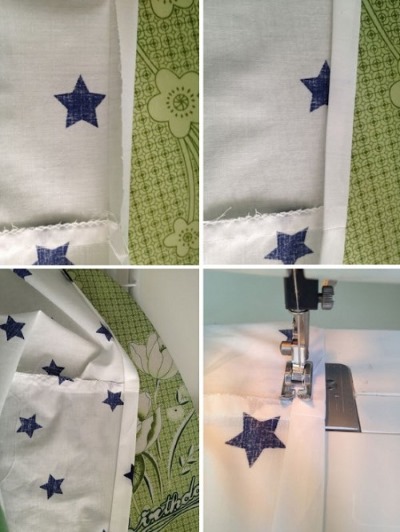
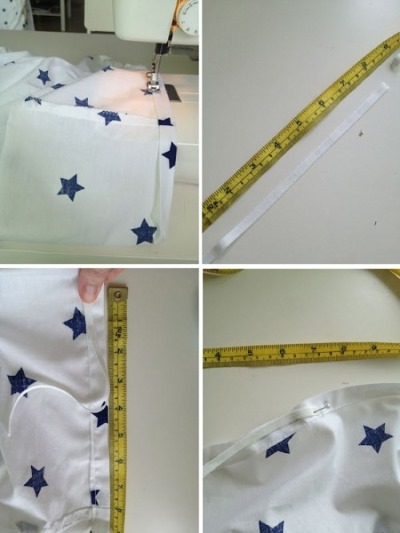

The technology for sewing a sheet with an elastic band in a drawstring is as follows:
- The material for work is wetted, dried and ironed.
- Prepare a drawing of the future product. The width of the mattress + 2 cm. From the corners of the drawing, measure a distance equal to the length of the mattress + 10 cm in all directions (gap for the mattress) and a gap for the insert for the elastic band.
- The corners are stitched twice: the edges are stitched with a 5 mm seam from the inside with a fastening at the end, the product is turned to the front side, straightened and stitched with a 7 mm stitch with a fastening. The sheet takes the form of a soft box.
- They try on the product.
- Along the inner sides of the product, a drawstring is stitched, taking into account the space for the elastic. In the future, the elastic can be taken out from here to make the ironing process easier.
- Thread the elastic. Its length corresponds to the perimeter of the product, divided in half.
- Connect the ends of the elastic band.
Elastic band sewn to the sheet at the corners
A fitted sheet made by yourself may not require any special sewing skills.

The convenience of such a device is that the bed linen does not get wrinkled on the bed during sleep.
There are several simple and inexpensive ways that will also help you achieve this goal.
| No. | Way |
| 1 |
|
| 2 | The sheet is attached to the mattress with an elastic band using iron clips or pins. |
| 3 | Make rubber inserts in a regular sheet as described in the method above. |
With clasps
In order for the sheet to lie as tightly as possible on the bed in the center and at the corners, additional elements are used - clasps. Such suspenders are available and easy to use. Their use does not completely replace the corner elastic, but provides strong tension across the entire mattress.
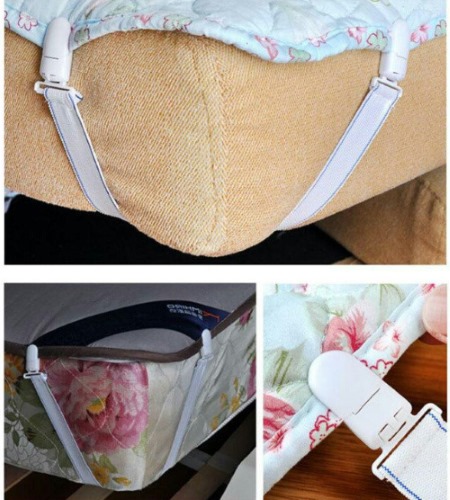
Clasps can be angular and transverse. The second type of suspenders pulls the sheet and fixes it on all sides. Using this fastening element allows you to reduce the material consumption, especially if several sheets are made at once. To do this, reduce the lower hem by 5-6 cm.
Fitted sheet with elastic band
Make markings with chalk or a simple pencil on the back of the fabric. Mark the edges of the mattress and select corner squares. The dimensions of the blank should exactly repeat the parameters of the mattress. To check, place the blank on top of the bed and cut off the excess fabric, remembering to leave fabric for inserting the elastic. Connect the corners on the back side, sew on the front side. Overcast the seams.
If the mattress has round corners, a pattern is made so that the sheet fits the mattress perfectly. A sheet of paper is cut to the shape of the corner of the mattress. The pattern is applied to the fabric and outlined. The sides are sewn to the rounded part and the side is passed along the joint of the parts.
A hem up to 2 cm wide is stitched around the entire sheet. An elastic band is threaded through the stitching and tied together at the ends. If necessary, it can be tightened after washing. When using a wide elastic band, it is either tied at the ends, or fixed at the beginning and end, or stitched along the entire length.
Sewing technology from ready-made sheets
A simple sheet can be converted into a product with an inserted elastic band, but it will sit on a narrow mattress.
To make it you need:
- sheet;
- measuring tape;
- sewing machine;
- wide elastic band.

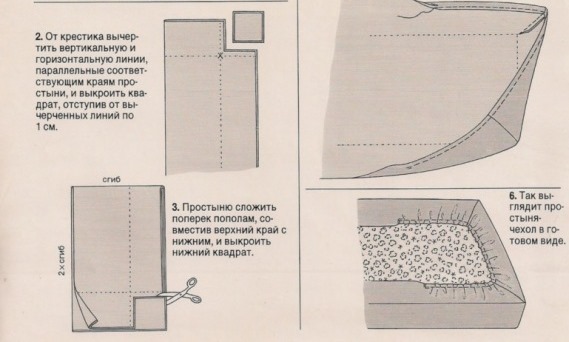
The process of creating a fitted sheet from a simple one does not require many skills, so It is often chosen by beginners who do not have enough experience in sewing:
- They measure the mattress for which they are sewing linen: length, width, height.
- Make a blank. Make square slits at the corners. Each side of the square is equal to the height of the mattress. Don't forget to leave room for the allowance.
- The cutouts are sewn from the inside. The sheet takes on the appearance of a soft box.
- A small hole is made on all sides of the product, an elastic band is inserted into it and secured at the ends.
- The edges are overlocked and stretched onto the mattress.
Fitted sheet for baby crib
A fitted sheet made by yourself is a great way to make comfortable bed linen for a child. For large mattresses, you need to buy fitted sheets separately or sew them yourself, due to the size of the bed. The width of large beds does not always allow you to tightly cover the bed with simple sheets.
If we are talking about children's beds, then the sheets are folded regardless of the size of the mattress. To make it comfortable for children to sleep, and to prevent folded bedding from interfering with sleep, mothers can make a sheet with an elastic band themselves.
Choice of fabric
When choosing a material, first of all, pay attention to the naturalness of the composition and that it is pleasant to the touch.
If the material is chosen for bed linen in a children's room, the selection criteria are expanded:
- The material composition mark gives an idea of how many natural and artificial fibers were used to create the material. Natural materials are more environmentally friendly than synthetic ones, but are more susceptible to wear.
- The quality of the material is affected by how long the fabric can last and how long the color will last. Some manufacturers save on production speed, which affects the strength or durability of the colors. You can check the quality of the dyes by rubbing them in your palms.
- The density is indicated by the manufacturer on the packaging.
- The cost of fabrics must correspond to the quality of the material and color fastness.
- Children's clothes should wash well and not cause allergic reactions.
Cotton fabrics will not cause allergies, it is a natural and pleasant material. Bamboo fiber fabric has antibacterial and absorbent properties.

Many people choose chintz because of its naturalness and availability, but this material wears out quickly. Calico products do not lose their shape even after numerous washes. Soft and pleasant to the touch fabrics are flannel, satin and jersey. At the same time, satin is wear-resistant, and the other 2 types can lose their shape and color.
How to calculate dimensions
When purchasing material for a future sheet, its tendency to shrink is taken into account. Before working with the fabric, it is washed, dried and ironed. Only after this procedure do they start cutting. To calculate the required amount of material for a children's mattress, use a simple formula, where W is the width of the mattress, D is the length, H is the height.
To calculate the width of the sheet, calculate: W + 2*H + 2*2 cm + 2*6 cm. To calculate the length of the sheet, calculate: D + 2*H + 2*2 cm + 2*6 cm. Once the calculations are made and verified, cut out the figure with the parameters obtained above.
How to sew
The diagram for making a fitted sheet for a child's bed is in many ways similar to the descriptions above:
- Cut off squares at the corners (15-16 cm). For convenience, fold the sheet in half twice.
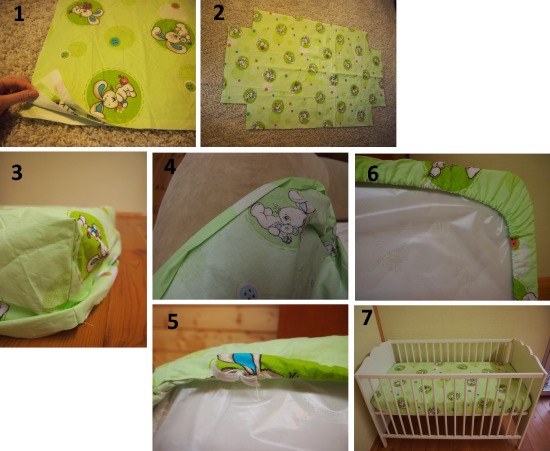
- On the reverse side, connect the sides of the cut with the front edges using a pin. The pattern takes the form of a soft box.
- The raw edges of the cuts are sewn with an overlock or other stitch.
- From the inside there are places where the middle seam joins.
- On the inside, form a hole for the elastic. To do this, fold the edges with cardboard and iron the fabric a little.
- On the long sides of the sheet, make 2 marks with chalk or pencil 15 cm from the corner seam. These marks indicate the beginning and end of the elastic.
- Sew a hem for the elastic band with a 1 cm gap at the chalk marks.
- The elastic is divided into 2 pieces and inserted into the hole from both sides, securing with a pin.
- At the attachment points, the elastic is firmly sewn to the sheet.
- The finished product is stretched over the mattress.
Making a fitted sheet with your own hands allows you to get bed linen that perfectly fits the size of any bed. For production, focus on your own sewing skills, choosing the most convenient method. For simplicity, use a sewn-on elastic band or clasps. A more complex method involves making a pattern for a children's or full-size sheet.
Article formatting:Natalie Podolskaya
Video about sewing a fitted sheet
Fitted sheet - pattern, how to sew (photo):
